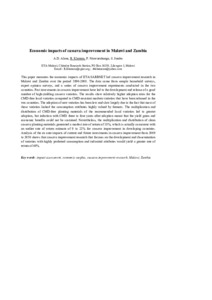| dc.contributor.author | Alene, Arega D. |
| dc.contributor.author | Khataza, R. |
| dc.contributor.author | Ntawuruhunga, Pheneas |
| dc.contributor.author | Mahungu, N.M. |
| dc.contributor.author | Jumbo, S. |
| dc.date.accessioned | 2019-12-04T11:07:52Z |
| dc.date.available | 2019-12-04T11:07:52Z |
| dc.date.issued | 2012-02 |
| dc.identifier.citation | Alene, A.D., Khataza, R., Ntawuruhungu, P., Mahungu, N.M. & Jumbo, S. (2012). Economic impacts of cassava improvement in Malawi and Zambia. In: Proceedings of the 11th triennial Symposium of the International Association of Hydrological Sciences held at Memling Hotel: Tropical roots and tuber crops and the challenges of globalization and climate changes, (pp. 78-82), Kinshasa, 4-8 October. Ibadan: ISTRC-AB. |
| dc.identifier.uri | https://hdl.handle.net/20.500.12478/1627 |
| dc.description.abstract | This paper measures the economic impacts of IITA/SARRNET led cassava improvement research in Malawi and Zambia over the period 1990-2008. The data come from sample household surveys, expert opinion surveys, and a series of cassava improvement experiments conducted in the two countries. Past investments in cassava improvement have led to the development and release of a good number of high-yielding cassava varieties. The results show relatively higher adoption rates for the CMD-free local varieties compared to CMD-resistant modern varieties that have been released in the two countries. The adoption of new varieties has been low and slow largely due to the fact that most of these varieties lacked the consumption attributes highly valued by farmers. The multiplication and distribution of CMD-free planting materials of the recommended local varieties led to greater adoption, but infection with CMD three to four years after adoption meant that the yield gains and economic benefits could not be sustained. Nevertheless, the multiplication and distribution of clean cassava planting materials generated a modest rate of return of 18%, which is actually consistent with an earlier rate of return estimate of 9 to 22% for cassava improvement in developing countries. Analysis of the ex ante impacts of current and future
investments in cassava improvement from 2009 to 2050 shows that cassava improvement research that focuses on the development and dissemination of varieties with highly preferred consumption and industrial attributes would yield a greater rate of return of 40%. |
| dc.format.extent | 68-77 |
| dc.language.iso | en |
| dc.publisher | International Association of Hydrological Sciences |
| dc.subject | Impact Assessment |
| dc.subject | Cassava |
| dc.subject | Technology Transfer |
| dc.subject | Economic Surplus |
| dc.subject | Cassava Improvement Research |
| dc.subject | Malawi |
| dc.title | Economic impacts of cassava improvement in Malawi and Zambia |
| dc.type | Conference Proceedings |
| cg.contributor.crp | Roots, Tubers and Bananas |
| cg.contributor.affiliation | International Institute of Tropical Agriculture |
| cg.coverage.region | Africa |
| cg.coverage.region | Southern Africa |
| cg.coverage.country | Malawi |
| cg.coverage.country | Zambia |
| cg.authorship.types | CGIAR single centre |
| cg.iitasubject | Agribusiness |
| cg.iitasubject | Cassava |
| cg.iitasubject | Research Method |
| cg.howpublished | Formally Published |
| cg.publicationplace | Ibadan, Nigeria |
| cg.accessibilitystatus | Limited Access |
| local.dspaceid | 82538 |
| cg.targetaudience | Scientists |


